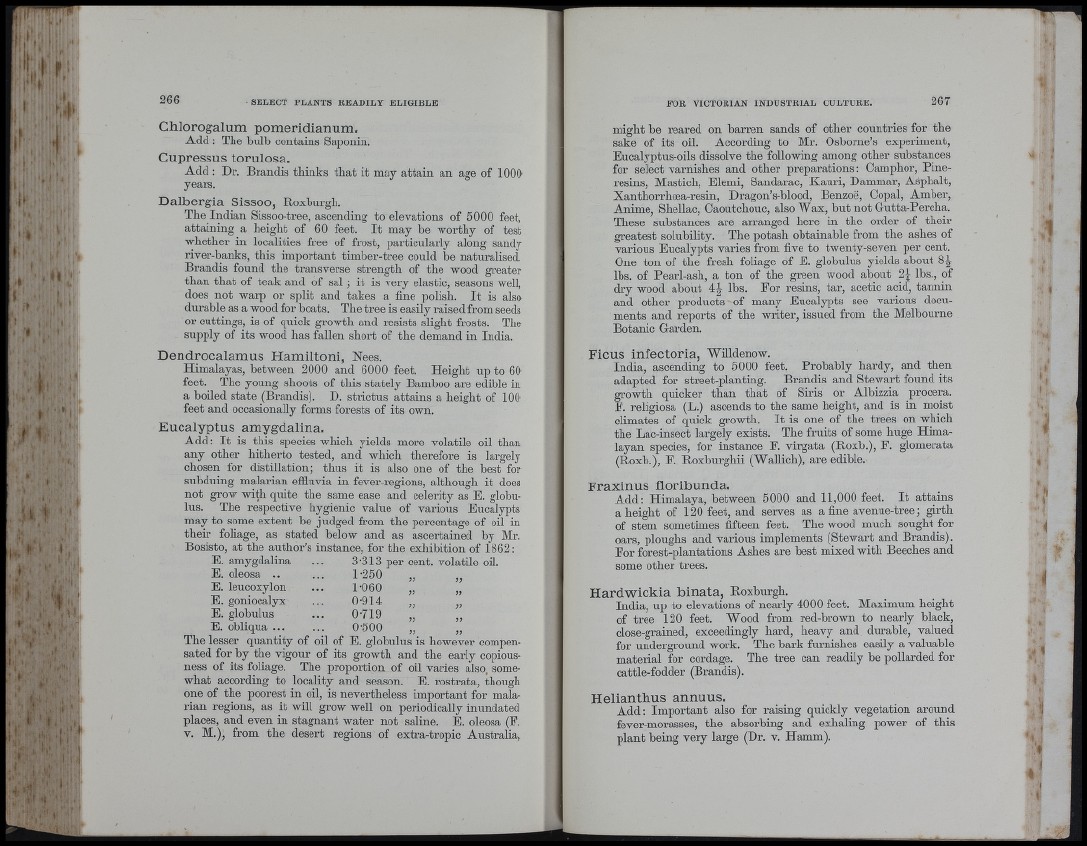
f
,'-r
I ,
1 ,
I
Chlorogalum pomeridianum.
Add : The bulb contains Saponin.
Cupressus torulosa.
Add : Dr. Brandis thinks th a t it may attain an age of 1000
years.
Dalbergia Sissoo, Roxburgh.
The Indian Sissoo-tree, ascending to elevations of 5000 feet,
attaining a height of 60 feet. I t may be worthy of test
whether in localities free of frost, particularly along sandy
river-banks, this important timber-tree could be naturalised.
Brandis found the transverse strength of the wood greater
than that of teak and of s a l; it is very elastic, seasons well,
does not warp or split and takes a fine polish. I t is also
durable as a wood for boats. The tree is easily raised from seeds
or cuttings, is of quick growth and resists slight frosts. The
supply of its wood has fallen short of the demand in India.
Dendrocalamus Hamiltoni, Nees.
Himalayas, between 2000 and 6000 feet. Height np to 60
feet. The young shoots of this stately Bamboo are edible in
a boiled state (Brandis). D. strictus attains a height of 100
feet and occasionally forms forests of its own.
Eucalyptus amygdalina.
A d d : I t is this species which yields more volatile oil than
any other hitherto tested, and which therefore is largely
chosen for distillation; thus it is also one of the best for
subduing malarian effluvia in fever-regions, although it does
not grow with quite the same ease and celerity as E. globulus.
The respective hygienic value of various Eucalypts
may to some extent be judged from the percentage of oil in
their foliage, as stated below and as ascertained by Mi\
Bosisto, at the author’s instance, for the exliibition of 1862:
E. amygdalina ... 3'313 per cent, volatile oil.
E. oleosa .. ... 1-250
E. leucoxylon ... 1-060
J?
E. goniocalyx ... 0-914
n
E. globulus ... 0-719
V
E. obliqua ... ... 0-500
The lesser quantity of oil of E. globulus is however compensated
for hy the vigour of its growth and the early copiousness
of its foliage. The proportion of oil varies also, somewhat
according to locality and season. E. rostrata, though
one of the poorest in oil, is nevertheless important for malarian
regions, as it will grow well on periodically inundated
places, and even in stagnant water not saline. E. oleosa (F.
V . M.), from the desert regions of extra-tropic Australia,.
might be reared on barren sands of other countries for the
sake of its oil. According to Mr. Osborne’s experiment,
Eucalyptus-oils dissolve the following among other substances
for select varnishes and other preparations: Camphor, Pine-
resins, Mastich, Elemi, Sandarac, Kauri, Dammar, Asphalt,
Xanthorrhoea-resin, Dragon’s-blood, Benzoe, Copal, Amber,
Ajiime, Shellac, Caoutchouc, also Wax, but not Gutta-Percha.
These substances are arranged here in the order of their
greatest solubility. The potash obtainable from the ashes of
various Eucalypts varies from five to twenty-seven per cent.
One ton of the fresh foliage of E. globulus yields about 8^
lbs. of Pearl-ash, a ton of the green wood about 2 | lbs., of
dry wood about 4|- lbs. Eor resins, tar, acetic acid, tannin
and other products of many Eucalypts see various documents
and reports of the writer, issued from the Melbourne
Botanic Garden.
Ficus infectoria, Willdenow.
India, ascending to 5000 feet. Probably hardy, and then
adapted for street-planting. Brandis and Stewart found its
growth quicker than that of Siris or Albizzia procera.
F. religiosa (L.) ascends to the same height, and is in moist
climates of quick growth. I t is one of the trees on which
the Lac-insect largely exists. The fruits of some huge Himalayan
species, for instance F. virgata (Roxb.), E. glomerata
(Roxb.), F. Roxburghii (Wallich), are edible.
Fraxinus floribunda.
Add: Himalaya, between 5000 and 11,000 feet. I t attains
a height of 120 feet, and serves as a fine avenue-tree; girth
of stem sometimes fifteen feet. The wood much sought for
oars, ploughs and various implements (Stewart and Brandis).
Eor forest-plantations Ashes are best mixed with Beeches and
some other trees.
Hardwickia binata, Roxburgh.
India, up to elevations of nearly 4000 feet. Maximum height
of tree 120 feet. Wood from red-brown to nearly black,
close-grained, exceedingly hard, heavy and durable, valued
for underground work. The hark furnishes easily a valuable
material for cordage. The tree can readily he pollarded for
cattle-fodder (Brandis).
Heliantbus annuus.
Add: Important also for raising quickly vegetation around
fever-morasses, the absorbing and exhaling power of this
plant being very large (Dr. v. Hamm).
%
r t